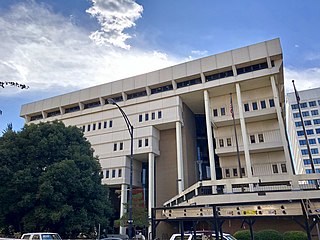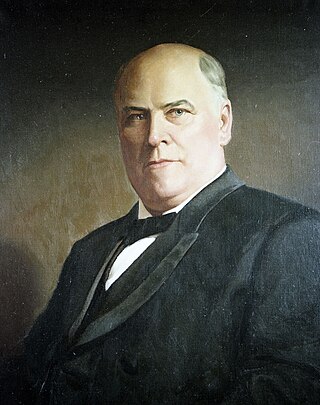
Forsyth County is a county located in the northwest Piedmont of the U.S. state of North Carolina. As of the 2020 census, the population was 382,590, making it the fourth-most populous county in North Carolina. Its county seat is Winston-Salem. Forsyth County is part of the Winston-Salem, NC, Metropolitan Statistical Area, which is also included in the Greensboro–Winston-Salem–High Point, NC, Combined Statistical Area. Portions of Forsyth County are in the Yadkin Valley wine region.

Oak Ridge is a town in northwestern Guilford County, North Carolina, United States. The population was 6,185 at the 2010 census, up from 3,988 in 2000. As of 2018, the population had risen to an estimated 6,977. Oak Ridge is 15 miles (24 km) northwest of the center of Greensboro, North Carolina's third-largest city, and it is a part of the Piedmont Triad urban area.

Kernersville is a town in Forsyth County, North Carolina, and the largest suburb of Winston-Salem. A small portion of the town is also in Guilford County. The population was 26,481 at the 2020 census, up from 23,123 in 2010. Kernersville is located at the center of the Piedmont Triad metropolitan area, between Greensboro to the east, High Point to the south, and Winston-Salem to the west. Some of the farmland surrounding the town has been sold and turned into large middle-to-upper-class housing developments.

Robert Brodnax Glenn was an American lawyer, prosecuting attorney, U.S. Attorney, and politician who served as a state senator and as the 51st Governor of the U.S. state of North Carolina from 1905 to 1909.
Pine Hall is an unincorporated community in Stokes County, North Carolina, United States, approximately ten miles southwest of county seat Danbury, near Belews Lake. Danbury and Sandy Ridge are to the north, with Stokesdale to the east. Kernersville and Walkertown are to the south, with Winston-Salem to the southwest. Walnut Cove and Germanton are located to the west. On March 20, 1998, a EF-1 tornado touched down briefly in the northern part of Pine Hall, north of Route 311 near Morning Star Baptist Church. The walls were knocked from the foundation of the church and windows were blown out because of the pressure. Trees were also knocked and blown over and 3 people were injured. It was on the ground for 1.5 miles before lifting near the Stokes/Rockingham County line. This tornado and system would eventually become the Stoneville Tornado from the 1998 Gainesville-Stoneville tornado outbreak.

Wallburg is a town in Davidson County, North Carolina, United States. It was incorporated in 2004. As of the 2020 census it had a population of 3,051.

Fisher Park is a neighborhood in the north central section of the United States city of Greensboro, North Carolina. Captain Basil J. Fisher turned a swamp into Greensboro's most fashionable Gilded Era address in 1901 when he donated the lowlands for a city park that bears his name. Residents took full advantage of ample lots overlooking the park by commissioning the city's best architects to design sometimes palatial homes. The neighborhood is recognized as Greensboro's first suburb, and is the city's most popular historic district.

Beaufort Historic District is a historic district in Beaufort, South Carolina. It was listed on the National Register of Historic Places in 1969, and was declared a National Historic Landmark in 1973.
South Main Street Historic District may refer to:
Cherry Street Historic District may refer to:

First Baptist Church, is a historic Baptist church located at 401 Oakhurst Street in Kernersville, Forsyth County, North Carolina. It was built in 1915–1916, and is a two-story cross-gabled brick building, with Gothic Revival and Tudor Revival style design elements. It has a cross-gable roof, three-stage corner entrance tower, and retains original furnishings.

The Cherry Hotel is a historic hotel building located at Wilson, Wilson County, North Carolina. It was designed by Charles Collins Benton in Beaux Arts style and built in 1917. It is a six-story, U-shaped brick building with approximately 200 rooms. The interior features a two-story lobby with Art Deco style lighting fixtures. The hotel closed in 1981. It was subsequently converted to apartments.

Black Mountain Downtown Historic District is a national historic district located at Black Mountain, Buncombe County, North Carolina. The district encompasses 56 contributing buildings and 1 contributing structure in the central business district of Black Mountain. The district includes a variety of late-19th and early-20th century commercial and institutional buildings in the Commercial Style, American Craftsman, Classical Revival, Art Deco and Art Moderne. Notable buildings include the George Stepp House (1907), Black Mountain Depot (1909), firehouse (1921) designed by Richard Sharp Smith, town hall (1927), Kaltman Building (1928), and Pure Oil Service Station.

Körner's Folly is a historic home located at Kernersville, Forsyth County, North Carolina, United States. It was built in 1880 by Jule Gilmer Körner, and is a 6,000 square foot, 3+1⁄2-story, eccentric brick dwelling with a shingled, cross-gable roof. It measures 48 feet on each side, with four bays. The house is said to have served originally as combination dwelling, stable, and carriage house, and featured an open carriageway running through the center of the house. Körner made his fortune by spearheading one of the first national advertising campaigns by painting murals of Bull Durham Smoking tobacco bulls on buildings and barns across the American east coast. In the 1870s he moved back to his hometown of Kernersville to build Körner's Folly and start an interior decorating and design business. After marrying Polly Alice Masten and having two children, Gilmer and Dore, Körner closed the carriageway and renovated the house to its present floor plan. The 22-room interior features unusual architecture and many examples of Victorian furniture and interior decoration since Körner used the house to showcase his business. Also on the property is a brick outbuilding – a small-scale version of the main house – which functioned as the "privy."

Isaac Harrison McKaughan House is a historic home located at Kernersville, Forsyth County, North Carolina. It was built about 1875, and is a two-story, L-shaped Italianate-style brick farmhouse. It has a central hall plan and two-room rear ell.
Roberts-Justice House is a historic home located at Kernersville, Forsyth County, North Carolina. It was built in 1877, and is a two-story, L-shaped Italianate style brick dwelling. It has a one-story rear kitchen ell. It was remodeled in 1916 in the Colonial Revival style.

Kernersville Depot is a historic train station located at Kernersville, Forsyth County, North Carolina. It was built by the Northwestern North Carolina Railroad in 1873. It is a plain one-story, mortise-and-tenon gable roofed building sheathed in board-and-batten siding in the Late Victorian style. It served as a depot until a new station was built in 1901. After that, it provided storage for the railroad and later for a farm and feed business.

North Cherry Street Historic District is a national historic district located at Winston-Salem, Forsyth County, North Carolina. The district encompasses 62 contributing buildings and 1 contributing object in a historically African-American residential section of Winston-Salem. The buildings date from about 1925 to 1951, and include notable examples of Colonial Revival and Bungalow / American Craftsman style architecture.

South Main Street Historic District is a national historic district located at Kernersville, Forsyth County, North Carolina. The district encompasses 53 contributing buildings, 2 contributing sites, and 2 contributing objects in Kernersville. They include residential and commercial buildings built between about 1834 and 1930 in a variety of popular architectural styles including Colonial Revival, Queen Anne, and Bungalow / American Craftsman style. Located in the district is the separately listed Korner's Folly. Other notable buildings include Spears House, Dr. Elias Kerner House (1857), Elias Kerner Huff House (1880), Greenfield and Kerner Tobacco Factory (1884), (former) Bank of Kernersville (1903), DeWitt Harmon's Office, Kernersville Moravian Church (1922), and Main Street United Methodist Church (1924/25).

The Arthur C. and Mary S.A. Nash House is a historic home in Chapel Hill, North Carolina, located at 124 South Boundary Street.


















